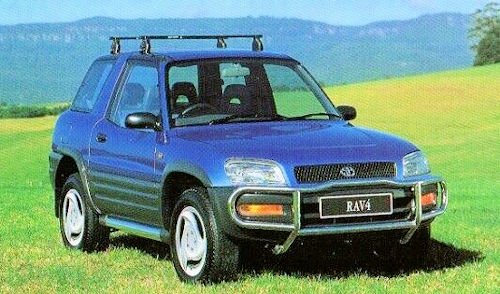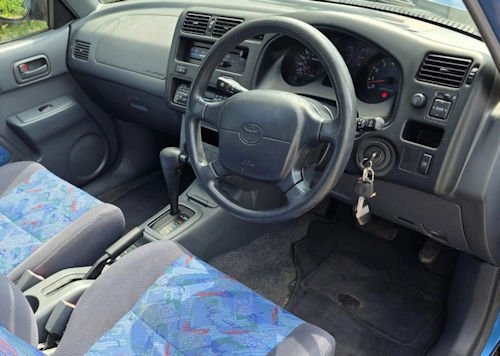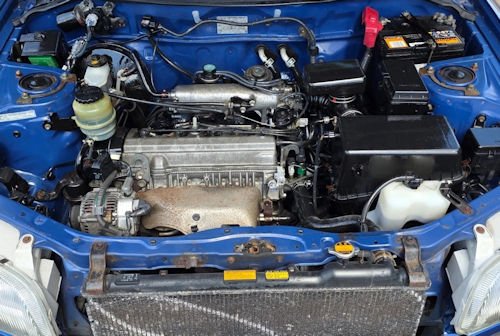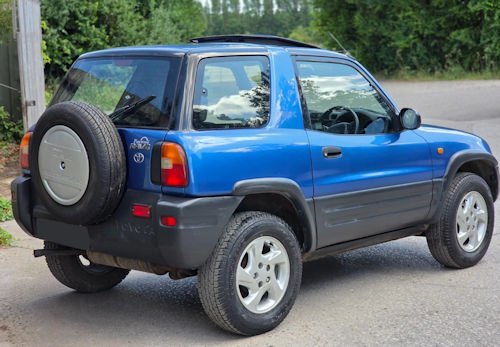Toyota RAV4 1st generation
 |
|
|
Model code |
XA10 |
|
Production |
1994–2003 |
|
Body style |
|
|
Engine |
|
|
Electric motor |
50 kW (67 hp), 190 NM (140 ft lb) (electric) |
|
Transmission |
|
|
Wheelbase |
|
|
Length |
|
|
Width |
1,695 mm (66.7 in) |
|
Height |
|
The RAV4 (Recreational Active Vehicle 4-Wheel Drive) is a compact SUV of the Japanese car manufacturer Toyota.
The vehicle was presented in the summer of 1994 in Europe and Japan, where it was presented in the US until the end of 1996. Like most modern SUVs, the RAV4 does not use the usual off-road ladder frame, but rather a self-supporting body.
The idea of combining the advantages of cars and off-road vehicles in this crossover concept has become an unexpected success for Toyota. The relatively light, raised, self-supporting body in conjunction with permanent all-wheel drive and a 95 kW (129 hp) 2.0-liter 16-valve gasoline engine knew how to convince both the automotive press and the clientele. The RAV4 quickly became a coveted lifestyle vehicle. In contrast to heavier and more expensive off-road vehicles, the RAV4 had no DE activatable four-wheel drive, no gear reduction or individually lockable differentials, Only the centre differential could be locked (centre differential lock only in conjunction with manual transmission). Nevertheless, this was offered due to the permanent four-wheel drive and the large ground clearance and the short body overhangs a very usable off-road capability. This was produced in Nagoya.
Initially, the RAV4 was offered from August 1994 only as a three-door, in February 1995 was also followed by the five-door with a significantly improved space. Due to the longer wheelbase the ride comfort was better and the handling more balanced.

Standard Equipment:
2.0-liter DOHC 4-cylinder engine, 5-speed manual transmission or 4-speed automatic transmission, driver- and passenger-side air bags, power steering, reclining cloth front bucket seats, split folding and reclining rear seat,front storage console, cupholders, dual outside mirrors, tachometer, trip odometer, coolant-temperature gauge, digital clock, rear defogger, intermittent front and rear wipers, 215/70R16 tires. 4WD models add: permanent 4WD.
Model maintenance
At the beginning of 1998, a first facelift was carried out with changes to headlamps, tail lights and radiator grille, as well as a revised interior. In addition, the model range was extended by a three-door based convertible.
Unchanged until the end of production remained the only available engine with two litres of displacement and 95 kW (129 hp). This was with a five-speed manual transmission or optional four-speed automatic combining a.
By the middle of 2000, production of the first generation of RAV4s had expired.

RAV4 EV (1997-2003)
From the end of 1997 Toyota also offered an all- electric car version of the RAV4 for the Californian market, after the then CARB laws forced the automakers to phased introduction of so-called zero-emission vehicles (ZEV).
The vehicles were only leased to the users. A purchase was (as with other EV manufacturers) at that time not possible.
Since the end of 2003, no more RAV4 EVs are being manufactured after pressure from the automotive industry eased the stringent emissions legislation in California. The automakers even tried to completely scrap the existing electric vehicles.
A total of 1575 RAV4 EVs were built. Today there are still about 800 RAV4 EV in traffic. These vehicles were u. a. Rescued by scrapping by Toyota through campaigns like Do not Crush.
The oil multinational Texaco (meanwhile Chevron) bought the patents for the production of the NiMH batteries and limited the production of large-sized NiMH cells world-wide. Toyota / Panasonic and other battery manufacturers were sued by Chevron. The historical correlations were in the published in 2006 documentary Why the electric car had to die shown.
The RAV4 EV reached a top speed of 126 km / h (78 mph) and had a range of 160 to 190 km (100 to 120 miles). Except for the electric powertrain, the RAV4 EV was identical to the model equipped with an internal combustion engine. To realize the brake booster an electrically driven vacuum pump was used for power steering and air conditioning worked electric motors. It was heated electrically.
As energy storage 95 Ah-NiMH cells were used with a total capacity of 27 kWh. Several RAV4 EVs have already achieved mileages over 150,000 miles (240,000 km) with the original traction battery. The RAV4 EV was charged with the Magne Charge Charging System developed by General Motors via an inductive, touch-safe "charging paddle". On the vehicle side, this paddle was inserted without contact into a loading slot. This charging system was also used on the GM EV1 and other vehicles from that period.

Technical
-
Specifications: 2-door 4 Door wagon
Wheelbase, in. 2-door 86.6 4 Door wagon 94.9
Overall length in. 2-door 147.2 4 Door wagon 163.4
Overall width, in. 2-door 66.7 4 Door wagon 66.7
Overall height, in. 2-door 65.2 4 Door wagon 65.4
Curb weight, lbs. 2-door 2469 4 Door wagon 2612
Cargo vol., cu. ft. 2-door 34.7 4 Door wagon 57.9
Fuel capacity, gals. 2-door 15.3 4 Door wagon 15.3
Seating capacity. 4
Front head room, in. 2-door 40.0 4 Door wagon 40.3
Max. front leg room, in.39.5
Rear head room, in. 2-door 38.6 4 Door wagon 39.0Powertrain layout:
transverse front engine/front-wheel drive or permanent 4-wheel drive.Engines
Size, liters/cu. in. 2.0/122
Horsepower @ rpm . 120 @ 5600
Torque (lbs]ft.) @ rpm..125 @ 4600© Motor car History
